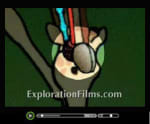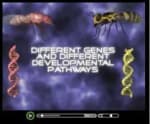Evidence For Evolution
Evidence for Evolution - The Icons of Evolution
The following "evidence for evolution" can be found in any biology textbook in any public school in the United States of America. Accompanying each supposed evidence for evolution is a brief explanation (ex) and the standard criticism (crit).
Evidence for Evolution - Homology:
(ex) Many animals have similar bone structures, giving the superficial appearance of relationship. (crit) Thought to have been evidence for common ancestry until significant advancements were made in biochemistry. Simply put, "Similarity does not imply a genetic relationship." (Dr. Walt Brown, "In the Beginning," 2001, p. 290.)
Evidence for Evolution - Embryology:
(ex) Embryos of different vertebrates look alike in their early stages, giving the superficial appearance of relationship. (crit) Embryos of different vertebrates DO NOT look alike in their early stages. "This idea was fathered by Ernest Haeckel, a German biologist who was so convinced that he had solved the riddle of life's unfolding that he doctored and faked his drawings of embryonic stages to prove his point." (William R. Fix, "The Bone Peddlers: Selling Evolution," 1984, p. 285.) Haeckel was exposed as a fraud in 1874 by Professor Wilhelm His. Nevertheless, Haeckel's fraudulent drawings (or similar representations) remain in high school and college biology textbooks to this day as evidence for evolution.
Evidence for Evolution - Observed Natural Selection
(Survival of the fittest): (ex) Darwin's proposed mechanism for evolutionary change is observed in nature. (crit) Natural selection serves as a means of conservation, not one of creation. It explains survival of a species, not arrival of a species. Here's an illustration: You work in a car factory. Your job is quality control - make sure the cars work like they are supposed to. You kick the tires and slam the doors, drive the cars around, etc. You identify and remove defects (an arbitrary selection with the same final result as natural selection). How long would it take for this selection process to turn one of those cars into an airplane naturally over time? It won't happen. "Natural selection may have a stabilizing effect, but it does not promote speciation [the arrival of a new species]. It is not a creative force as many people have suggested." (Daniel Brooks "A downward Slope to Greater Diversity," Science, Vol. 217, 24 September 1982, p. 1240.)
Besides, while survival of the fittest is observed in nature, it is not absolute. We also observe survival of the weakest and survival of the luckiest. Every infant is the weakest of a species, and yet obviously, some of them survive or there would be no species at all. Similarly, when a whale swims through a school of fish swallowing 80%, the 20% that survived were not the fittest - they were the luckiest. Somehow "survival of the fittest" has become tautology. Only the fittest survive. How do we determine they were the fittest? Because they survived!
Evidence for Evolution - The Fossil Record:
(ex) Supposed "missing links" between distinct kinds of animals which can be extrapolated as transitions between kinds. For example, Archaeopteryx is thought to be a transition between reptiles and birds. (crit) There are no unambiguous transitional fossils. Archaeopteryx was thought to be a transition between reptile and bird because of its teeth and the claws on its wings. The fact is some fossil birds had teeth, and some didn't. Some reptiles have teeth, and some don't. Some mammals have teeth, and some don't. As far as claws on its wings, there are birds living today that have claws on their wings. Nevertheless, they are obviously birds, and no one disputes this. Besides, superficial similarities do not imply genetic relationship. "There is not one such fossil for which one could make a watertight argument. The reason is that statements about ancestry and descent are not applicable in the fossil record." - Colin Patterson, Senior Paleontologist at the British Museum of Natural History and editor of a prestigious scientific journal. Patterson is a well-known expert having an intimate knowledge of the fossil record. (Reference: Colin Patterson, personal communication. Luther Sunderland, "Darwin's Enigma," 1988, p. 89.)


